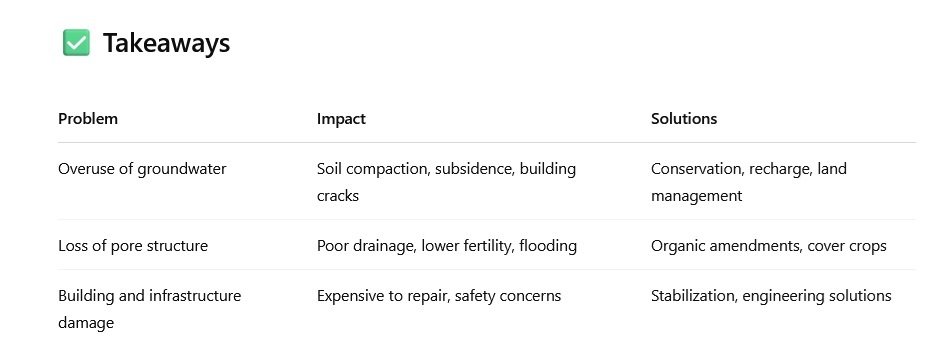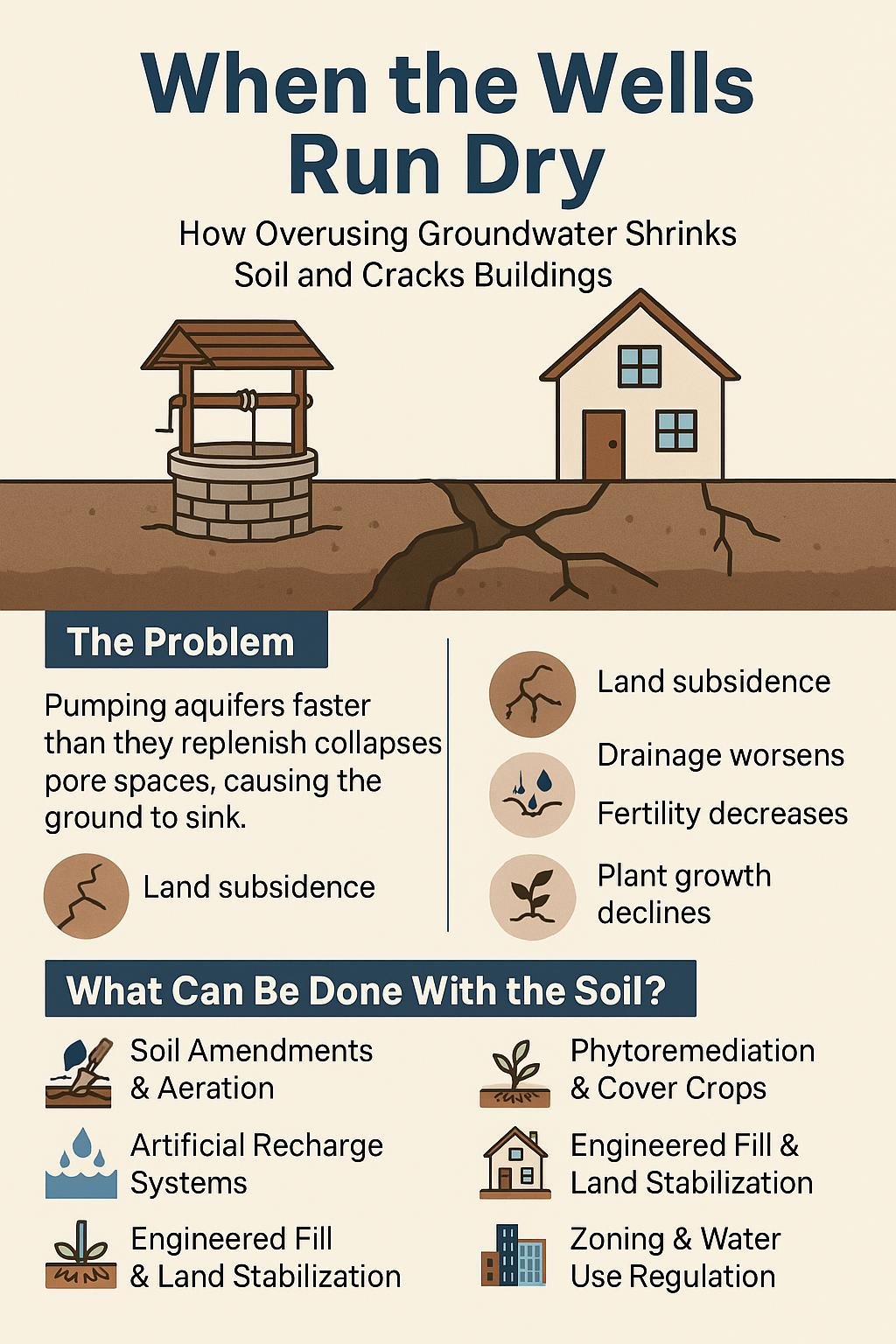Water is life—but when overused, it can also lead to destruction beneath our feet. Across the globe, the over-extraction of groundwater from wells is causing more than just empty aquifers. It’s leading to soil compaction, land subsidence, and even cracks in buildings, roads, and critical infrastructure.
This growing crisis affects both rural and urban areas and calls for urgent attention. In this article, we’ll explore how groundwater depletion shrinks soil, damages property, and what strategies can be used to restore or stabilize the land once the water is gone.
💧 The Problem: Groundwater Overuse and Soil Collapse
When water is pumped out of underground aquifers faster than it can be replenished, pore spaces in the soil begin to collapse. These voids once filled with water provide structure and buoyancy. Without water, fine-grained soils like clay and silt compress and settle.
This process leads to a phenomenon called land subsidence—the gradual sinking of the Earth's surface. It’s not just a theoretical concern:
-
In California's Central Valley, parts of the land have sunk over 30 feet in the past century.
-
In Jakarta, buildings tilt and roads crack as groundwater is depleted.
-
In Arizona, entire subdivisions experience foundation damage as the land beneath them contracts.
🧱 Cracks in Buildings and Infrastructure
The consequences aren’t limited to the environment—they hit close to home:
-
Foundations crack as soil shrinks and settles unevenly.
-
Walls separate, creating gaps around doors and windows.
-
Pavement buckles, damaging roads and pipelines.
-
Wells themselves become unusable, as the water table drops below the reach of existing pumps.
These effects are often irreversible and can be very costly to repair—not just for homeowners, but for entire communities.
🌍 What Happens to Soil When the Water Runs Out?
Once groundwater is depleted, soil structure is permanently changed:
-
It compacts, becoming denser and less capable of holding moisture.
-
Soil fertility decreases, impacting agriculture.
-
Drainage worsens, increasing flood risk during storms.
-
Plant growth declines, due to reduced root aeration and harder layers near the surface.
In many cases, recharging the aquifer doesn’t bring the soil back to its original state. The damage is done.
🛠️ What Can Be Done With the Soil After Groundwater Depletion?
While soil recovery is difficult, it’s not impossible. Here are strategies to manage or rehabilitate affected areas:
1. Soil Amendments and Aeration
-
Biochar, compost, and gypsum can improve structure and restore porosity.
-
Deep tilling or mechanical aeration can break up compacted layers (though care must be taken not to damage soil health further).
2. Phytoremediation and Cover Crops
-
Planting deep-rooted species like vetiver, switchgrass, or alfalfa can help open up compacted soils.
-
Cover crops such as clover or rye add organic matter and improve water retention.
-
Over time, these methods can rebuild soil health and fertility.
3. Artificial Recharge Systems
-
Constructing infiltration basins, recharge wells, or check dams can help capture rainfall and guide it back into the aquifer.
-
This works best when combined with soil rehabilitation strategies to enhance percolation.
4. Engineered Fill and Land Stabilization
-
In areas where buildings are damaged or future development is planned, engineered fill (such as geotextile layers or compacted gravel) may be necessary to create a stable base.
-
Soil grouting and slab jacking can lift and stabilize existing structures.
5. Zoning and Water Use Regulation
-
The best fix is prevention. Limiting groundwater extraction, monitoring well use, and enforcing sustainable water policies are key.
-
Smart urban planning can prevent development in high-risk areas.
🌱 Community Action and Long-Term Recovery
Soil shrinkage and structural damage are not isolated problems. They affect:
-
Homeowners
-
Farmers
-
Municipal planners
-
Engineers
-
Environmentalists
Solutions require collaboration across sectors:
-
Public education on water conservation and groundwater risks
-
Incentives for soil restoration or xeriscaping
-
Monitoring systems that track land movement and groundwater levels
-
Funding for remediation in subsiding communities

🧭 Final Thoughts
As groundwater becomes scarcer, the hidden costs beneath our feet begin to surface—literally. Land that once supported homes, farms, and communities is shrinking, cracking, and collapsing.
But there is hope. Through restorative soil practices, smarter water use, and proactive planning, we can protect our foundation—both in the ground and in society.
